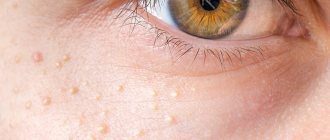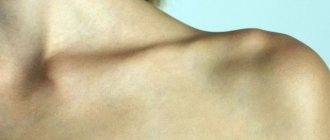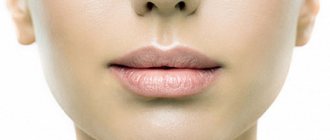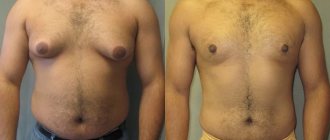Cheilitis is an isolated inflammatory process in the area of the mucous membrane, skin and red border of the lips. Outwardly it looks like swelling with redness and peeling of tissue. It can be an independent disease or a symptomatic manifestation of other pathologies. Sooner or later, almost every person encounters it, but at a young age the disease is noticeably milder, recurs less often and has no complications. In older people, due to a weakened immune system, periodic relapses of cheilitis can cause malignant tissue degeneration.
Causes
Cheilitis is a polymorphic and multifactorial disease that can be triggered by infections, physical and chemical environmental factors, as well as internal characteristics of the body. Among them:
- constant exposure to the open air - inflammation and peeling of the lips occurs when chapped by hot or cold air, excessive insolation;
- the presence of chronic diseases with skin manifestations of symptoms - various types of dermatitis, psoriasis, lupus erythematosus, lichen planus, syphilis, etc.;
- allergic reactions of the body - mainly with food allergies;
- tissue irritation from regular exposure to chemicals, including medications (for example, nasal drops);
- various neurological disorders, severe stressful situations, depression, constant anxiety;
- endocrine abnormalities - primarily hyperfunction of the thyroid gland, diabetes mellitus.
Types of cheilitis
Manifestations of cheilitis may vary depending on the type and cause of the disease. There are:
- Exfoliative cheilitis - manifested by peeling of the red border of the lips, with rare areas of burning and dryness of the lips themselves.
- Exudative cheilitis - symptoms of the disease are supplemented by swelling and severe pain. The skin in inflamed areas may become covered with baked crusts, which greatly complicate the patient’s life.
- The glandular form affects the minor salivary glands. Their congenital or acquired proliferation is observed, followed by infection with bacteria. In this case, the source of infection can be caries, periodontitis or banal plaque. Outwardly it manifests itself as the formation of cracks on the surface of the lips, which begin to become wet over time.
- The allergic form occurs under the influence of household, cosmetic or food irritants (often this is lipstick). There are characteristic manifestations of allergic cheilitis in musicians who play wind instruments and in those who like to chew pencils. This type of inflammation is characterized by severe swelling, often with the formation of blisters, as well as itching, severe redness and burning.
- Meteorological cheilitis develops under the influence of weather conditions (wind, sun) and is manifested by burning, itching with small weeping blisters, in place of which erosions and ulcers form over time.
- The atopic form manifests itself as a symptom of dermatitis or neurodermatitis. Manifests itself in the form of redness and ulcers in the corners of the lips.
- The hypovitaminosis type of the disease is formed in response to a severe lack of vitamins, mainly vitamins A, C, B2. A characteristic burning sensation affects the surface of the lips, mouth and tongue. The mucous tissues take on a swollen appearance, cracks on the lips peel and bleed.
- Macrocheilitis is a response to damage to adjacent nerves (facial nerve neuritis), while itching and swelling from the tongue can spread to other parts of the face.
Attention! With a long course, there is a high probability of inflammation degenerating into a malignant neoplasm. This is especially typical for the meteorological form, which, in the absence of proper treatment, is often complicated by precancerous diseases.
How to care for your lips?
Proper lip care includes:
- use of scrubs. Light particles gently remove dead skin cells, activate blood circulation, and rejuvenate the mucous membrane. Immediately after the procedure, you may feel tingling and heat in your lips, but this is normal. Due to the mechanical effect, blood circulation accelerates, and the mechanisms of regeneration of mucosal cells are launched. For proper lip care, a scrub made from honey and granulated sugar is suitable. Mix the components, apply to the mucous membrane and spread over the surface with patting movements, stroking for 30 seconds. The Vaseline-based scrub also received positive reviews. The product gently cleanses the mucous membranes and moisturizes the skin around the mouth. By doing this procedure once a week, you will delay the appearance of facial wrinkles around the lips;
- regular lip masks. Oil masks can restore dry mucous membranes on the lips. Apply warmed olive or cocoa butter to the skin for 20 minutes. Afterwards, remove the remains with a napkin. A mask of fatty sour cream will serve as a nourishing agent and a light acid peel for the mucous membrane. This recipe is suitable for women over 35 who want to restore the beautiful color of the mucous membrane and the tenderness of the skin around the mouth. If you lack hydration, then a mask made from cucumber and avocado will do. Grind vegetables in equal proportions, add a couple of drops of olive oil and apply on lips for 10 minutes. In winter, this lip care can be done once every 3 days;
- balms. Every time you go outside, after eating or drinking water, apply a moisturizer to your lips. It is better if it is a nutritional composition based on aloe, cocoa butter, shea butter, and honey. But it is better to avoid coloring pigments and flavors for cracked lips. These substances on damaged skin can cause rashes, allergic reactions and swelling;
- makeup removal. Long-lasting matte lipsticks and pigmented moisturizing glosses must be removed from the mucous membrane not by washing with soap, but with special products. Two-phase makeup removers are an excellent option for proper care of the skin around the lips. The first phase removes pigmentation and cosmetics, the oily phase will protect against drying out and moisturize the mucous membrane;
- features of summer lip care. To prevent photoaging and the appearance of purse-string wrinkles around the mouth, summer lip care includes the use of sunscreen balms and glosses with SPF factors. For a city, a protection level of 15-20 units is suitable. If you are going to the sea or to the mountains, then buy a balm with spf from 25 units. Dermatologists also advise not to forget about drinking balance when properly caring for your lips in the summer. By drinking 1.5 liters of water a day, you will protect the mucous membranes from drying out and peeling;
- features of winter lip care. Ultraviolet radiation, cold wind and frost are tests for delicate skin and mucous membranes. Unlike the neck and forehead, this area of the face is always visible and not covered by clothing. Therefore, it freezes and dries out first. To prevent cracks and dryness of the mucous membrane, before each exit, apply a balm containing aloe vera, honey, cocoa butter, and hyaluronic acid. Hygienic lipsticks with ceramides and glycerin seal moisture inside the mucous membrane, forming a protective fatty film on the lips;
- what to do if your lips are chapped. If the skin around your mouth has already begun to peel and crack, then do not try to bite or cut it off. Apply a thick layer of nourishing healing balm or at least chapstick. If such a remedy is not at hand, then honey will help. Distribute a couple of drops of sweetness over the mucous membrane. Nutrient components, vitamins and natural antiseptics will heal wounds and cracks overnight and restore the beautiful color of the thin skin around the mouth.
Diagnosis of cheilitis
There are no specific laboratory tests to detect cheilitis. All diagnosis of the disease is carried out by visual examination. To determine the causes of inflammation, diagnostics of the gastrointestinal tract may be prescribed for the presence of Crohn's disease or ulcerative colitis. Additionally, allergy tests are performed to exclude food allergies.
General laboratory tests allow you to check the condition of the body and determine the possible causes of cheilitis:
- low levels of vitamins due to hypovitaminosis can provoke exfoliative cheilitis;
- bacterial cultures of smears and biopsies are performed in patients with immune system disorders in the absence of results from the treatment;
- testing for markers of HIV infection, herpes, the presence of fungal or bacterial microflora, respectively, allows us to identify the viral, bacterial or fungal causative agent of cheilitis;
- a blood test for anemia, ESR are required to assess general health;
- examination of the function of the thyroid and pancreas for endocrine pathologies.
On a note! Cheilitis tends to be chronic with periodic relapses. Self-healing without medical supervision is almost impossible, so try to pay attention to such a “minor” problem and consult a specialist. Diagnosis of the disease is carried out by a general practitioner or attending dentist. In some cases, consultation with an allergist, infectious diseases specialist, dermatovenerologist or gastroenterologist may be required.
Diagnosis of Sjögren's disease
When diagnosing Sjögren's disease, it is necessary to take into account not each symptom individually, but the totality of symptoms. If there are at least 4 factors, then it is highly likely that the patient has Sjögren’s disease.
Here they are:
- enlarged parotid salivary glands;
- Raynaud's syndrome (poor circulation in the hands or feet);
- dry mouth;
- increase in ESR,
- the appearance of joint problems;
- frequent outbreaks of chronic conjunctivitis.
Laboratory diagnostic methods are used to confirm Sjögren's disease.
A general blood test often reveals anemia, moderate leukopenia, increased ESR, biochemical analysis shows an increased level of γ-globulins, total protein, fibrin, etc.
Immunological reactions include increased levels of immunoglobulins IgG and IgM, pathological autoantibodies.
The Schirmer test reveals low production of tear products in response to stimulation with ammonia. Staining the sclera with special dyes makes it possible to detect erosion of the epithelium.
Diagnosis also includes contrast radiography, biopsy of the salivary glands, ultrasound of the salivary glands, MRI of the lacrimal/salivary glands.
X-rays of the lungs, gastroscopy, and ECHO-CG are often required (this makes it possible to identify complications affecting other organs and systems of the body).
1 Treatment of Sjögren's disease
2 Consultation with a nephrologist
3 Consultation with an ophthalmologist
Treatment
Different forms of cheilitis differ in their approach to treatment. Collectively, the impact may include:
- correction of the psycho-emotional sphere - a neurologist prescribes sedatives, tranquilizers, a psychologist or psychotherapist conducts appropriate psychotherapy;
- physiotherapy - treatment with laser, ultrasound, magnetotherapy, electrophoresis is prescribed locally; they relieve irritation and accelerate tissue regeneration;
- drug symptomatic therapy - non-hormonal anti-inflammatory drugs are prescribed; in case of severe inflammation - hormonal drugs;
- immunotherapy – strengthen the immune system by taking immunomodulators and immunostimulants;
- vitamin therapy - taking vitamins A, C, group B (mainly vitamin B2) is of great importance;
- surgical treatment – typical for glandular cheilitis with enlargement of the salivary glands; Both laser ablation with a surgical laser and direct removal of areas of the gland are used;
- antiallergic therapy with antihistamines.
Additionally, the doctor may prescribe diet therapy with the exclusion of foods that provoke allergies or chemical irritation of tissues (spicy foods, saltiness and marinades). When staying outdoors for a long time, it is imperative to use special protective equipment.
Clinical picture of Sjögren's disease
All symptoms of Sjogren's disease can be divided into glandular and extraglandular .
Glandular symptoms of Sjögren's disease
Glandular symptoms of the disease manifest themselves in a decrease in the production of glandular secretions.
One of the main symptoms of Sjögren's disease is inflammation of the eyes associated with a decrease in the secretion of ocular fluid. Patients are bothered by a feeling of discomfort: burning, scratching, “sand” in the eyes. At the same time, people often experience swelling of the eyelids, redness, and accumulation of white viscous fluid in the corners of the eyes. At the next stage of the disease, patients begin to complain of photophobia and deterioration of visual acuity.
The second constant symptom of Sjögren's disease is inflammation of the salivary glands, which becomes chronic. The patient complains of dry mouth and enlarged salivary glands. At the onset of the disease, there is slight or intermittent dry mouth, which appears only as a result of excitement or physical activity. Then dry mouth becomes permanent, the mucous membrane and tongue dry out excessively, become bright pink and often become inflamed, and dental caries progresses rapidly.
Sometimes, before these signs appear, the patient may experience “unreasonable” enlargement of the lymph nodes.
The late stage of the disease is characterized by severe dry mouth; it becomes very difficult for a person to talk or swallow solid food without drinking water. Cracks appear on the lips. Chronic atrophic gastritis may appear with insufficiency of secretion, which is accompanied by belching, nausea, and loss of appetite. Every third patient at a late stage has an enlargement of the parotid glands.
Damage to the bile ducts (cholecystitis), liver (hepatitis), and pancreas (pancreatitis) is observed.
At a late stage of the disease, the nasopharynx becomes very dry, dry crusts form in the nose, otitis media and hearing loss may develop. Due to dryness in the larynx, hoarseness appears.
Secondary infections appear: often recurrent sinusitis, tracheobronchitis, pneumonia. Every third patient experiences inflammation of the genital organs. The mucous membrane is red and inflamed.
1 ECHO-KG
2 Gastroscopy
3 Chest X-ray
Extraglandular symptoms
Extraglandular symptoms of Sjögren's disease are quite varied and systemic in nature. These are joint pain, stiffness in the morning, muscle pain, muscle weakness.
Most patients note an increase in the submandibular, cervical, occipital, and supraclavicular lymph nodes.
Half of the patients experience inflammation of the respiratory tract: dry throat, sore throat, scratching, dry cough and shortness of breath.
Sjögren's disease can manifest itself as cutaneous vasculitis, rashes on the skin of the lower leg, then on the skin of the abdomen, thighs, and buttocks. This is accompanied by skin irritation, burning sensation and fever.
Every third patient experiences allergic reactions to certain antibiotics, B vitamins, washing powder, and food products.
Lymphomas may develop in Sjögren's disease. The situation is aggravated by the fact that Sjogren's disease often develops against the background of other (primarily rheumatic) diseases.
Prevention
The main prevention of cheilitis is maintaining a healthy lifestyle and timely treatment of any infectious and allergic diseases. Basic list of measures:
- Eat right - a balanced menu should contain an abundance of fruits, vegetables, herbs, nuts, fish, and high-quality dairy products.
- Reduce the use of cosmetics - try to choose hypoallergenic formulations and constantly monitor the skin's reaction.
- Dose your exposure to open wind or direct sunlight.
- Protect your lip skin from physical and chemical damage.
- Take vitamin and mineral complexes periodically in courses (after consultation with your doctor).
- Give up bad habits.
- Seek medical advice promptly if you have characteristic symptoms.
Remember: your health is the greatest value, and constant monitoring of its condition is very important to maintain the body’s performance, especially in old age.








